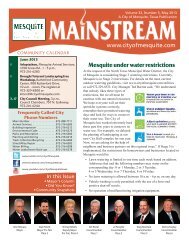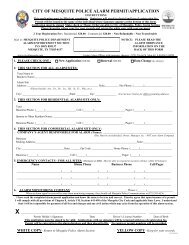airport/documents/Mesquite Master Plan Final.pdf - The City of ...
airport/documents/Mesquite Master Plan Final.pdf - The City of ...
airport/documents/Mesquite Master Plan Final.pdf - The City of ...
Create successful ePaper yourself
Turn your PDF publications into a flip-book with our unique Google optimized e-Paper software.
easonable capacity should start at<br />
approximately 210,000 operations.<br />
FAA Order 5090.3C, Field Formulation<br />
<strong>of</strong> the National <strong>Plan</strong> <strong>of</strong> Integrated<br />
Airport Systems (NPIAS), indicates that<br />
improvements to capacity should be<br />
considered when operations approach<br />
60 to 75 percent <strong>of</strong> the airfield’s annual<br />
service volume (ASV). If the projected<br />
long range planning horizon level <strong>of</strong><br />
operations comes to fruition (166,500),<br />
the airfield’s ASV will exceed the 60<br />
percent level shortly after the<br />
intermediate planning horizon. Thus,<br />
additional airfield capacity enhancements<br />
should be considered part <strong>of</strong> this<br />
master plan.<br />
<strong>The</strong> most typical and effective<br />
enhancement to airfield capacity is the<br />
construction <strong>of</strong> a parallel runway.<br />
Construction <strong>of</strong> a parallel runway would<br />
increase the airfield’s ASV to as much<br />
as 300,000 operations. Other capacity<br />
enhancements include construction <strong>of</strong><br />
additional taxiways and improved<br />
navigational instrumentation. For<br />
<strong>Mesquite</strong> Metro Airport, construction <strong>of</strong><br />
additional exit taxiways will not<br />
significantly alleviate congestion due to<br />
the adequacy <strong>of</strong> existing taxiways.<br />
Navigational aid improvements,<br />
including GPS improvements and lower<br />
minimums for the southerly approach,<br />
would provide some relief during poor<br />
weather conditions.<br />
<strong>The</strong> construction <strong>of</strong> a parallel runway<br />
provides the best capacity increase to an<br />
airfield system. This process, however,<br />
is very costly and TxDOT will require<br />
that the project be justified in order to<br />
receive funding assistance. Quantifying<br />
existing demand without the aid <strong>of</strong> an<br />
3-13<br />
<strong>airport</strong> traffic control tower (ATCT) is a<br />
difficult task. Another consideration for<br />
construction <strong>of</strong> a parallel runway at<br />
<strong>Mesquite</strong> Metro Airport is the lack <strong>of</strong><br />
available <strong>airport</strong> property suitable for<br />
construction. This would require the<br />
acquisition <strong>of</strong> adjacent property which<br />
is currently planned for other industrial<br />
uses.<br />
For planning purposes, however,<br />
consideration will be given to the<br />
construction <strong>of</strong> a parallel runway in the<br />
long range planning period. Establishing<br />
the potential for a parallel<br />
runway will provide the <strong>City</strong> with an<br />
option for development <strong>of</strong> adjacent<br />
property. This option will be explored<br />
further in the next chapter.<br />
RUNWAYS<br />
<strong>The</strong> adequacy <strong>of</strong> the existing runway<br />
system at <strong>Mesquite</strong> Metro Airport has<br />
been analyzed from a number <strong>of</strong><br />
perspectives, including runway<br />
orientation, runway length, pavement<br />
strength, width, and safety standards.<br />
From this information, requirements for<br />
runway improvements were determined<br />
for the <strong>airport</strong>.<br />
Runway Orientation<br />
<strong>The</strong> <strong>airport</strong> is served by single runway<br />
system. Runway 17-35 is orientated in<br />
a north-south manner. For the<br />
operational safety and efficiency <strong>of</strong> an<br />
<strong>airport</strong>, it is desirable for the runway to<br />
be oriented as close as possible to the<br />
direction <strong>of</strong> the prevailing wind. This<br />
reduces the impact <strong>of</strong> wind components<br />
perpendicular to the direction <strong>of</strong> travel




